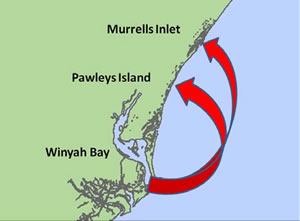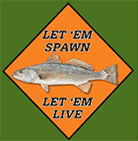Red Drum Habitat and Recruitment Dynamics
One of the chief advantages of producing and releasing red drum into South Carolina estuaries is the ability to follow the survival and dispersal of hatchery-raised fish into the wild population. Advances in genetic identification methods allow SCDNR’s stock enhancement research program to distinguish hatchery red drum from wild fish and to trace an individual fish back to its release group. With this technology, we are able to evaluate experimental factors like release location, timing of release and size at release. By utilizing these techniques in a northern South Carolina estuary, Murrells Inlet, we’ve been able to answer questions about red drum habitat suitability and dispersal that would be impossible without the use of cultured animals.
Murrells Inlet is a very small estuary, encompassing only 2.4 square miles at high tide, and less than half of that at low tide. The system is characterized by high salinity and very little freshwater input. Its small size and isolation from adjacent estuaries make it an ideal location to study the impacts of experimental red drum enhancement. In the fall of 2002-2005 and again in 2007-2008, “fingerling” red drum (~1 inch) were harvested from nursery ponds at the Waddell Mariculture Center, taken to Murrells Inlet and transported by boat to flooded spartina habitat where they were acclimated and released (table 1).
Table 1. Stocking and contribution of fingerling red drum in Murrells Inlet.
| Year Class/Year Stocked | Number Stocked | Contribution |
|---|---|---|
| 2002 | 553,088 | 7.5% |
| 2003 | 604,807 | 0% |
| 2004 | 585,558 | 22.4% |
| 2005 | 625,269 | 4.7% |
| 2007 | 110,131 | 0.0% |
| 2008 | 60,825 | 0.0% |
In order to evaluate the contribution of these hatchery fish to the wild population, we worked with local recreational anglers who donated the carcass of every red drum they caught. We used ear bones (otoliths) from the fish to determine age and collected a fin clip for DNA analysis to determine if it was a hatchery fish or a wild fish. Contribution for each of these release years is calculated as the proportion of stocked fish to wild fish. Despite high stocking numbers for such a small area, fingerling hatchery fish typically made a very small contribution to the wild population. By comparison, similar stocking numbers in Winyah Bay and the Ashley River, which are much larger estuaries, have led to contributions that have often exceeded 30%.
The low contributions made by fingerling hatchery red drum suggest that Murrells Inlet may not provide the best habitat for small red drum to survive. To test this hypothesis, a genetically distinct larger size class of red drum, (5-6 inches), was stocked in the system during 2006 and again in 2009. These fish were grown in ponds at the Waddell Mariculture Center in Bluffton, SC and transported to Murrells Inlet, where they were released directly at the public boat ramp.
Despite being stocked in much smaller numbers than the 1 inch fish, these larger fish made much higher contributions to the red drum population (table 2). The relative success of the larger fish further confirmed that a bottleneck appears to occur within Murrells Inlet that limits the survival of small fish. When larger fish are stocked that bypass these limitations, they are able to survive and make an impact on the fishery. As is often the case in scientific research, this study raised even more questions about red drum recruitment and survival. If natural recruitment, meaning the number of fish that settle into the inlet as larvae and grow within the system, is poor in Murrells Inlet, where do the larger wild fish come from? And what is the source of this bottleneck that affects the smallest sizes of fish within the system.
Table 2. Stocking and contribution of yearling red drum in Murrells Inlet.
| Year Stocked | Number Stocked | Size Stocked (inches) | Contribution (%) |
|---|---|---|---|
| 2006 | 8,000 | 5.0 | 78.3 |
| 2009 | 1,505 | 6.0 | 18.8 |
During the fall of 2007 and 2008, fingerling red drum, similar to those stocked in Murrells Inlet but genetically distinct, were stocked in Winyah Bay. The results of that effort have helped us to better understand red drum recruitment and survival in the region. When we evaluated the contribution of hatchery fish stocked in Murrells Inlet in 2007, we detected that five 1 inch fish stocked in Winyah Bay had migrated up to Murrells Inlet. The following year, an additional two fish stocked in Winyah Bay were identified in Murrells Inlet samples and another two were collected from Pawley’s Island, just south of Murrells Inlet (fig. 1).

The poor survival of fingerling red drum stocked in Murrells Inlet and these unexpected migrations may be related to habitat availability. In their earliest life stages, red drum prefer to spend their time in small subtidal creeks surrounded by spartina marsh. These “nursery” areas provide both food and protection from predators. Such habitats are very limited in Murrells Inlet during high tide and virtually absent during low tide. Despite the lack of nursery habitat, Murrells Inlet is characterized by significant oyster coverage and appears to provide suitable habitat for older, larger fish. These characteristics may help explain why fish stocked as small juveniles exhibit poor survival, but fish stocked at a larger size survive and contribute to the population.
Winyah Bay, on the other hand, is a large estuary with abundant amounts of nursery area that is suitable for survival of small fish. Human development is sparse in comparison to Murrells Inlet and strong freshwater input provides nutrients that encourage growth of the small animals down the food chain that provide prey for fingerling red drum.
SCDNR’s long-lining survey routinely captures adult red drum within Winyah Bay and it is a well-known spawning location for adult fish during the fall. The conditions within Winyah Bay are conducive to the survival of large numbers of larval and fingerling red drum. As these fish grow, they move out of the nursery areas and into larger tidal creeks and main bodies of water. They require more space during this time and are more dependent on mud flats and oyster beds to provide food and protection from predators. If Winyah Bay produces more fingerling red drum than it can support, perhaps some leave Winyah Bay in search of suitable habitat around Pawleys Island and Murrells Inlet, where they find both food and protection from predators.
Under this hypothesis, Winyah Bay serves as a “source” and Murrells Inlet and Pawleys Island serve as a “sink” for juvenile red drum. The exact timing of this migration is not known; we only know that it occurs sometime between fingerling size (1-2 inches) and when the fish recruit to the recreational creel (15 inches). While further stocking research will be necessary to answer these questions, the use of stocked fish that are genetically identifiable has allowed us to evaluate red drum dispersal patterns and habitat limitations that wouldn’t otherwise be possible.



